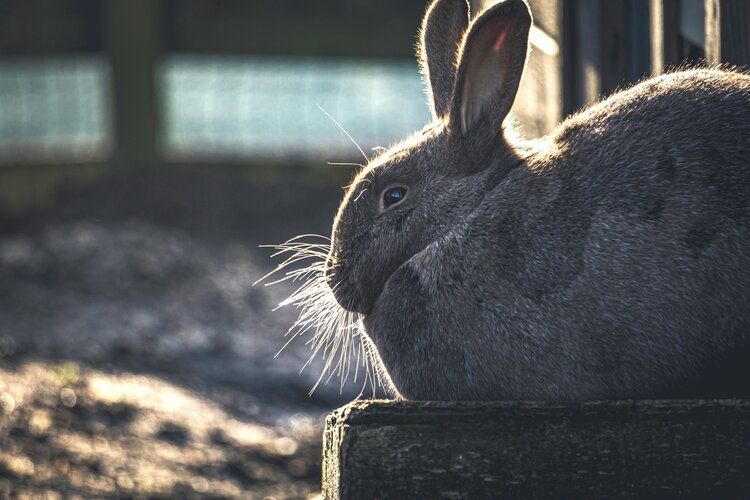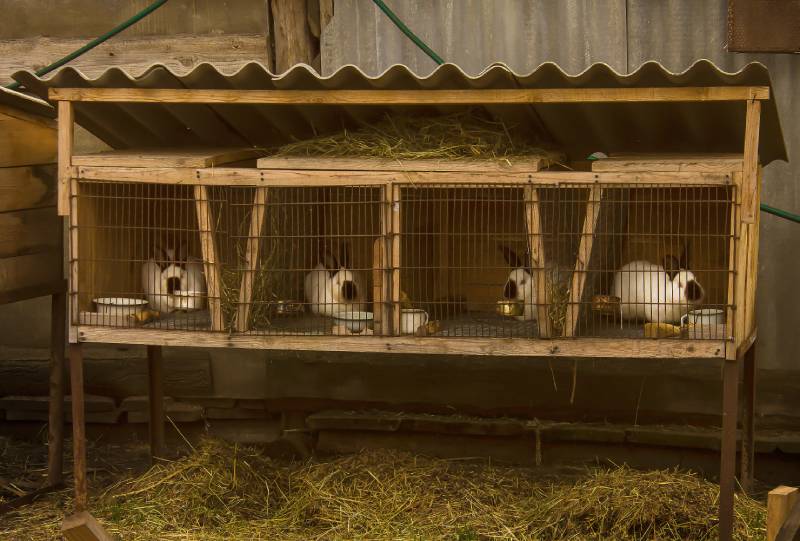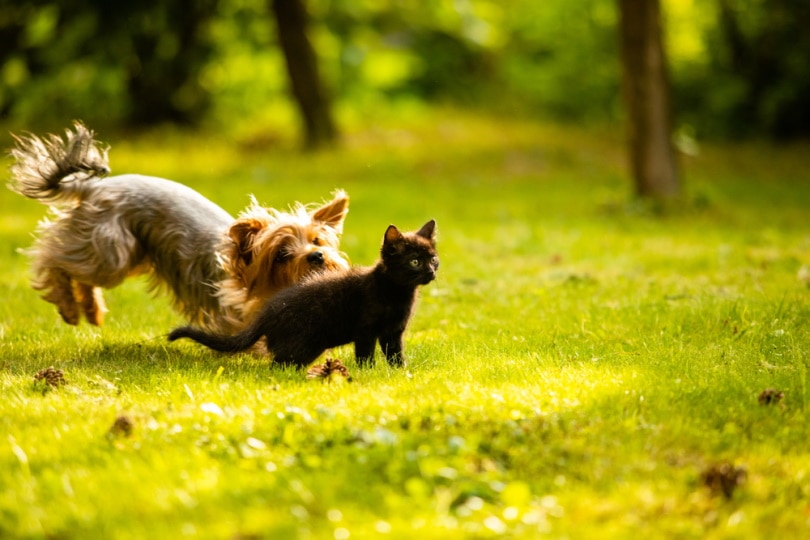
If you’re looking for tips to weatherproof a rabbit hutch, you’re in the right place. This post brings you some advice and guidance on protecting your rabbit and its hutch from adverse weather conditions.
Owning and raising rabbits can be a fun, exciting experience. But, with great fun comes great responsibilities. You are now responsible for caring for and nurturing a small mammal. Have you thought about its safety during the worst of weather, as well as threats from predators?
Most people don’t consider this. The weather plays a huge part in your fluffy friend’s well-being. From high heat in the summer to the freezing weather in the winter, you need to be prepared to adapt your rabbit’s hutch for all weather.
Why Weatherproof Your Hutch?
Rabbits are highly adaptive creatures in their own environment. They spend a lot of their time in fields and valleys and are accustomed to a variety of different weather conditions. With that being said, when you take a rabbit out of their natural habitat you remove their ability to find shelter and have access to their burrow which they can hide in when the weather gets too intolerable.
A way to remedy their lack of ability to burrow and find shelter on their own is to make sure you weatherproof according to the weather. This includes insulating during colder weather to prevent freezing, shading during extreme heat to prevent heat exhaustion, and even sheltering from extreme winds that cause damage to your rabbit hutch. All of these have to be constantly considered when owning and caring for a rabbit.
The Risks of Not Weatherproofing
As we just explained the importance of weatherproofing your hutch, we will explain the possible risks you may run into if you neglect to weatherproof your rabbit hutch. First and foremost, if you do not weatherproof your rabbit hutch, you run the risk of your pet becoming very ill or even dying.
The Cold

Extreme cold weather conditions can cause your rabbit’s body temperature to drop dangerously low risking your pet’s health or even causing your animal to freeze. This is because rabbits, though accustomed to cold temperatures, are usually able to create burrows to stay warm.
These burrows are underground and prevent the rabbit from freezing in the winter months. So since they are unable to burrow on their own, not weatherproofing will hurt your rabbit.
The Heat

On the other side of the spectrum, extreme heat can also be detrimental to your pet’s health. As explained before, rabbits in the wild can roam free. This means that when it is extremely hot in the summer months they can wander around and seek out shade when they become too hot.
If you do not provide the essential shade to your hutch your rabbit may become overheated causing it to become overheated and become ill or even cause your rabbit to die.
The Wet

Rain is another factor to consider. If you failed to weatherproof your hutch against rain your hutch will become very wet. This can compromise the structure of your hutch. Rain and moisture can get trapped in the wood of your hutch. This can cause the wood to mold which can, in turn, cause your rabbits to get sick. Along with mold, moisture will also break down the wood and cause your hutch to slowly fall apart.
In addition to harming the overall structure of your hutch, rain can also have ill effects on your rabbit. The constant moisture in your hutch can cause skin issues for your rabbit. Also, the dampness can make it very hard for your rabbit to stay warm, which in turn can cause your rabbit to become ill.
The Wind
Another weather element that most people don’t think about is wind. Though wind isn’t as detrimental to your pet’s health as much as other weather elements are, it can affect the overall structure.
Strong winds may cause a non-weatherproofed hutch to tip over and break. In turn, if your hutch falls over, it can harm your rabbit by squishing it under the broken hutch. This is why it is highly recommended that you do indeed weatherproof your rabbit hutch or simply bring your rabbit indoors.
Considerations
Now that you are thoroughly convinced of the importance of weatherproofing your rabbit’s hutch, what do you do now? Well, before you run out and do anything there are a few things you should consider before weatherproofing.
Do you have prolonged winters or tons of wind? Or are you in a more temperate climate with short, mild winters but more extreme summer heat? All of these factors must be considered before planning how to weatherproof.
One would not be expected to insulate and weatherproof the same in, say, southern California, where the weather is hotter and winters extremely mild, compared to Michigan, for example, where they have very harsh winters and extreme cold. Another thing to consider before weatherproofing your rabbit hutch is whether or not simply bringing your rabbits indoors during extreme weather would be an option.
Bringing your rabbit indoors is the best and most simple option as an alternative to weatherproofing your rabbit hutch. Understandably, not everyone has this option. If it is an option for you, this would cut down greatly on the amount of preparation you make to weatherproof your rabbit hutch.
5 Useful Techniques to Weatherproof Your Hutch
Once you have determined the amount of weatherproofing that is needed for your specific climate, you are now ready to dive into the project of actually weatherproofing your rabbit hutch. Because climates are different, we will outline here the main things to do to protect your hutch and your rabbit from inclement weather.
1. Elevate it from the Ground
First and foremost, when building a hutch you should try to keep it up off the ground. In winter months the ground freezes and when it rains, it becomes wet and muddy. If your hutch is on the ground it will make it much more difficult to keep your rabbit dry and warm.
By simply building your hutch up on stilts you will eliminate this problem and find it much easier to regulate the temperature of your hutch. Also, it is important that you build your hutch out of pressure-treated wood. This will help seal out any moisture and prevent your hutch from breaking down over the years.

2. Slanted Roof
Also, be sure to build your hutch with a slanted roof. This will help rain and snow drain off the roof and away from your hutch, keeping your rabbit’s home warm and dry.
3. Create Shade for the Hutch
If your location is subject to extreme heat, it would be advisable to create shade for your hutch. You can do this by simply building your hutch in a location where it is shaded most of the time. This would provide your rabbit with cool shade and you won’t have to worry about your rabbit overheating. Another way to combat the heat would be to build a small den inside your rabbit hutch. This will provide your rabbit with an escape from the harsh elements. A small den will also mimic a burrow which is your rabbit’s natural home.

4. Extra Insulation
If you are in a location that is subject to snow and freezing temperatures, you will want to somehow insulate your rabbit hutch. You can do this in several ways. One way is to cover the top of the cage with plastic. The plastic will act as a barrier to the outside elements. It keeps heat inside your hutch while blocking out the freezing temperatures.
Be sure NOT to secure the hutch completely with plastic. Plastic is not a breathable material and therefore if you completely secure the whole hutch with plastic you will also eliminate the ability for your rabbit to get fresh air and risk possible suffocation. Also, if the plastic is too close to the mesh you risk your rabbit eating it and becoming sick.
You can also put some more rabbit hay inside the hutch for extra warmth.
5. Wind Protection
To weatherproof against extreme winds is pretty simple. You can simply build your hutch up against a structure such as a shed, barn, or even your house. If you wish to further protect your rabbit hutch against the wind, you can take it a step further and simply anchor your rabbit hutch to the building it is up against.
Rain, in our opinion, is the hardest to weatherproof against. Rain gets into cracks and crevices and stays cold and damp for a long time. The best way to combat moisture and rain would be to make sure your roof is properly secure and leak-free.
In addition to this, be sure to always change out your rabbit’s bedding frequently during rainy seasons. If you don’t change out your rabbit’s straw, it will become moldy and damp and, as stated above, will cause health problems to your rabbit.
Another way to way to easily weatherproof your rabbit hutch is to simply build it inside a mini barn or shed. This will add extra insulation to your hutch keeping it warmer. In addition to this, being inside a shed or barn will also give the hutch and rabbits protection against wind, rain, and snow. Besides having your rabbits indoors with you, this, in our opinion, is the best option.
Final Thoughts
As you can see, there are many, many factors to consider when weatherproofing your rabbit hutch, all of which are very important. You should always take all of these things into consideration when weatherproofing your rabbit hutch.
Weather is an unpredictable thing at times so it is always important to check your weatherproofing frequently. You never know when the wind might blow the plastic off or rain may soak through all of the dry bedding. The absolute best way to fully protect your rabbits is to keep them indoors. If you absolutely must leave your rabbits outdoors during harsh weather, please weatherproof their hutch.
Now that you know how to weatherproof your rabbit hutch, why not check out these great examples of outdoor rabbit hutches?
Featured Image: Martin Skarregaard, Unsplash










